May 31, 2023
The Ultimate Guide to Reducing Online Cart Abandonment for Enterprise Retailers
By Liza Colburn

The average online cart abandonment rate is over 70%. It can get as high as 80% for mobile shoppers. It’s an all too common problem, even for the most popular retailers. What causes such high cart abandonment rates? What can retailers do to reactivate more carts and close more e-commerce sales? Let’s take a deep dive into cart abandonment, why it happens and what e-commerce leaders can do about it.
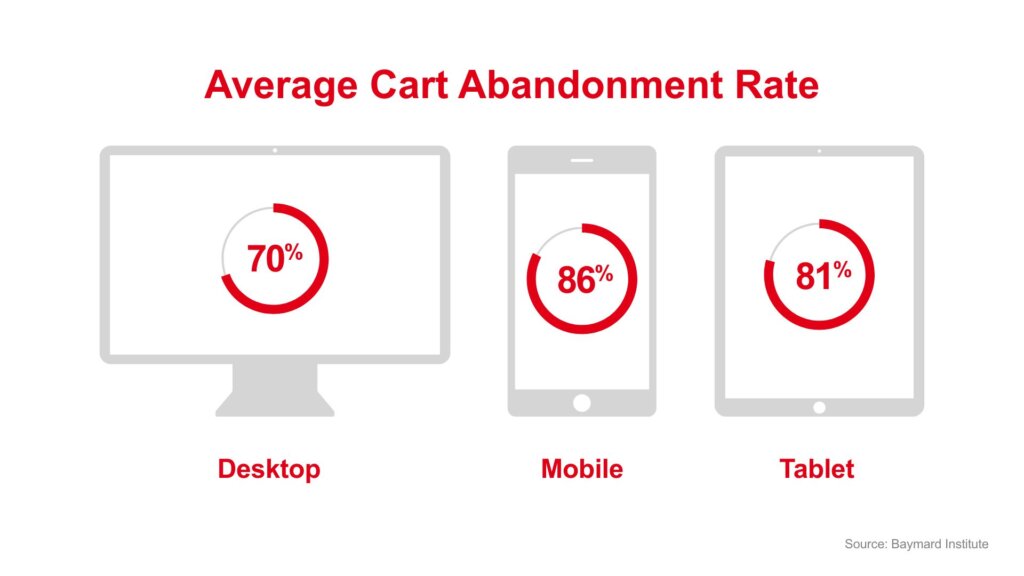
What is online cart abandonment?
Online cart abandonment occurs when e-commerce customers select an item or items for checkout, but don’t complete the full process by paying for the order. In other words, the consumer initiates a purchase but does not finalize it. This occurs for various reasons including lack of trust, uncertainty around the purchase, or a complicated checkout process.
There are known strategies for improving your abandoned cart recovery rate. Some of them come down to simplifying the checkout experience, which retailers have made quite cumbersome. Too many steps, a lack of transparency, and failing to provide consumers with a personalized checkout experience all contribute to high e-commerce cart abandonment. Fortunately, retailers are starting to realize the cost of not providing a seamless and personalized checkout process.
Note: There are distinct differences between cart abandonment vs. checkout abandonment.
Average Cart Abandonment Rate Across Sectors
Cart abandonment rates tend to vary by sector and even by sub-sector. For example, different sectors within retail see different cart abandonment trends. High ticket items tend to have the highest cart abandonment rates. This is likely because consumers need more time to decide whether the purchase is worth it. Essentials that consumers buy over and over again have much lower cart abandonment rates, in contrast.
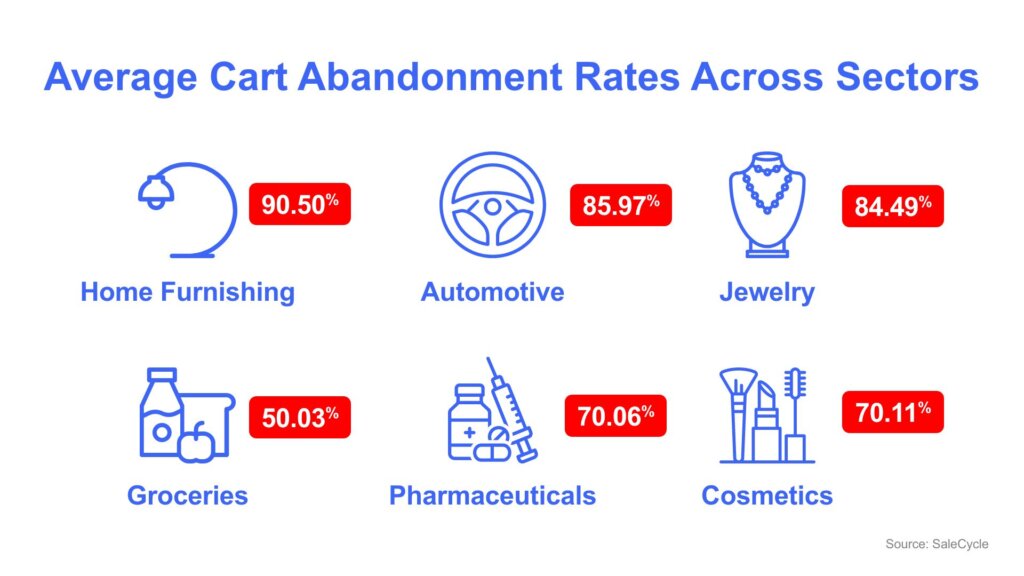
Why is cart abandonment such a problem?
Online cart abandonment isn’t just a missed sale. It’s a missed opportunity to engage with and “wow” a customer. E-commerce customers who abandoned their carts are sending the brand a message. Perhaps the website is too slow or the checkout process too long. Maybe they don’t like the return policy or were surprised by the extra delivery fees they saw only after beginning the checkout process. For whatever reason, the customer spent time browsing the site, but changed their mind or weren’t ultimately sold enough to cross the finish line.
Cart abandonment is expensive. It costs retailers $18 billion in e-commerce sales each year. On top of that, brands spend significant marketing dollars getting the customer to the site and getting them interested enough to add products to the cart. If the customers don’t complete the sale, it creates a negative ROI on all that marketing effort. Cart abandonment also skews a brand’s performance data and can even reduce website speeds.
Digital shopping cart abandonment negative effects
If e-commerce retailers don’t find new ways to build trust and engagement at the time of purchase, they will continue to see abandoned digital shopping carts and millions of dollars in lost sales. Cart abandonment negative effects are rampant throughout retail and e-commerce. Let’s explore a few ways brands experience negative effects from digital shopping cart abandonment through lost ad spend, technical issues, and higher operating costs.
Higher customer acquisition costs or CAC
Customer acquisition costs are rising rapidly throughout e-commerce. The decline and eventual elimination of cookies, which provided retailers with cost-effective retargeting, contributes to these rising costs. Enterprise retailers are also investing in more digital marketing ad campaigns and channels than ever. Social media, influencer marketing, content marketing, SEO, SEM, email marketing, and more create insatiable demand for different types of content. While these marketing efforts may drive traffic, they don’t always drive an equal share of sales.
Recovering more abandoned carts can greatly improve customer acquisition cost and provide more accurate data about digital marketing campaign effectiveness. Some strategies for recovering abandoned carts include cart abandonment emails, SMS reminders, time limits on how long items are reserved in the cart, and personalized language in the online cart.
Pro Tip: Some experts suggest adding a “mini cart” functionality to your e-commerce site to keep the cart visible during browsing.
Decreased customer lifetime value or LTV
Customer lifetime value refers to the profits or margin a retailer or brand can expect to make throughout the relationship with a customer. The more the customer buys from a brand and the higher their order value, the more the lifetime value of that customer will be. Customers who abandoned their carts have the potential to be high value customers. But, they weren’t convinced or confident enough to complete their purchase.
First-time customers only become regular customers when they feel engaged with the brand. One way to build trust throughout the digital shopping experience is through personalization. This goes beyond putting a customer’s name on an email or sending them a discount on their birthday. More advanced personalization involves recommending products the customer wants, using digital marketing messaging that resonates with them, and adding value and ease to their shopping experience. E-commerce brands can build a long-standing customer relationship through personalized, dynamic messaging. Learn how to start with the cart.
Inventory management and availability issues
When a customer adds an item or items to their online cart, the item is temporarily unavailable for someone else to purchase. Lack of product availability can result in lost sales and frustrated customers who come to the e-commerce store intent to buy something that appears to be out of stock. Reducing cart abandonment can greatly reduce these inventory issues.
Missed opportunities to connect with customers
High cart abandonment rates mean that e-commerce retailers need to find new and innovative ways to engage with and build trust with customers, and reinforce their purchasing decisions. In order to achieve this, e-commerce leaders who want to reduce digital shopping cart abandonment should go through every step and channel of the digital customer journey to identify ways they’ve added value and opportunities to add personalization. This includes the shopping cart, which is one of the less optimized steps in the customer journey.
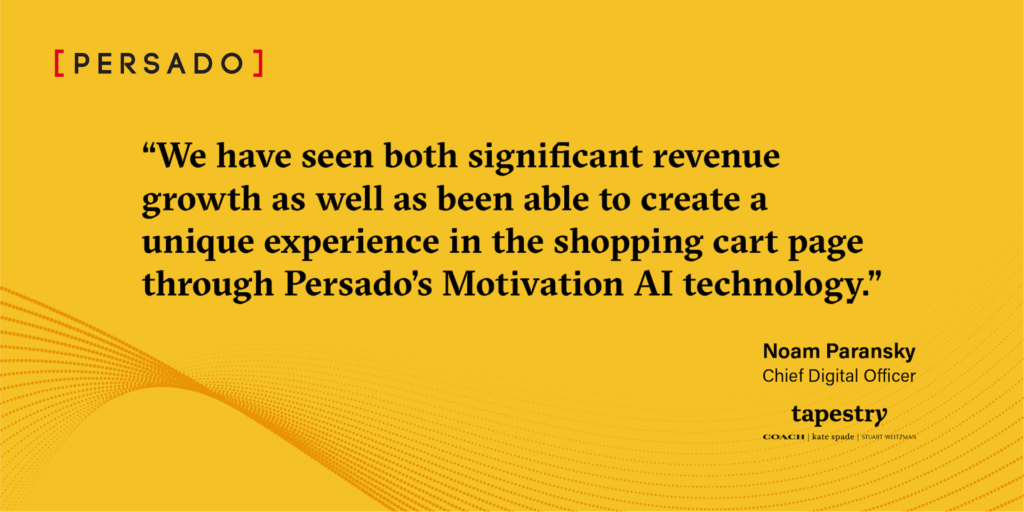
Costly discounts
When customers abandon their carts, some brands automatically send them discounts in order to close the deal via email or exit pop ups. This may be effective in the short-term, but it’s a flawed strategy long-term. Retailers should be cautious when discounting items or offering other incentives. Discounting items in abandoned carts can cheapen the brand, result in lower margins, and attract a different kind of customer who is only looking for coupons. Not to mention, customers have gotten used to seeing this and will purposely abandon their carts to see if they can get 10-20% off.
Top 10 Reasons for cart abandonment and solutions
As mentioned, some common reasons why customers abandon carts include unexpected costs or extra costs (shipping, tax, fees), account creation requirements, shipping delays, a complicated checkout process, or they were conducting research to buy later. For consumers who are still in the information gathering phase, displaying the right words on the checkout page personalized to their unique data profile could motivate them to complete their purchase. Let’s explore some of the reasons for cart abandonment during checkout more closely and what retailers should do instead.
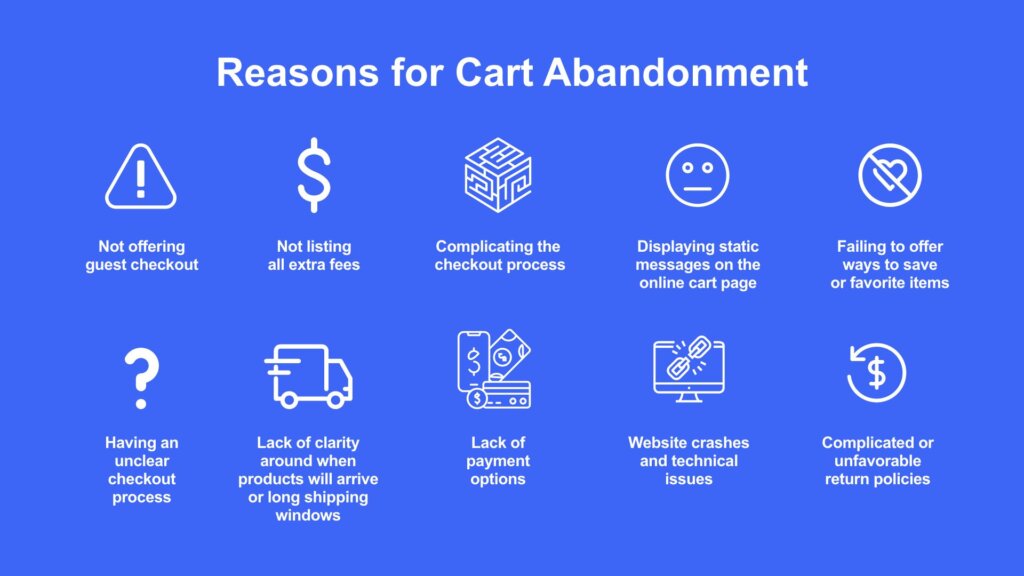
Reason #1: Not offering guest checkout
Solution: Offer a guest checkout option:
Allow customers to checkout without having to create an account or sign up for some offer. This can reduce friction in the checkout process. Customers are more likely to complete their purchase if they don’t have to create an account right away.
Reason #2: Not listing all extra fees, including shipping costs, taxes, etc.
Solution: Clearly display all fees in the product listing:
Extra costs are the most common reason for cart abandonment, accounting for 48% of abandoned carts. Display all fees, including shipping costs, taxes, and any other charges, clearly in the listing. If customers see these extra costs for the first time in their online shopping cart, they are likely to second guess their purchase. Customers want to see the total cost of their purchase before they hit “add to cart”.
Reason #3: Complicating the checkout process
Solution: Simplify the checkout process:
Streamline the checkout process as much as possible. Reduce the number of steps required to complete the checkout process and minimize the amount of information customers need to enter. If there are unnecessary steps in the checkout process, remove them.
Reason #4: Displaying static messages on the online cart page
Solution: Personalize the language in the online cart:
Today’s consumers are more likely to purchase from brands that personalize the online shopping experience. While brands have invested in personalization across the digital shopping journey, the online cart, the most significant step in the online journey, is left static and unchanged. Persado Dynamic Motivation uses the session data along with Generative AI and our Motivation AI knowledge base to deliver messaging in the online cart to motivate each customer to complete their purchase, anonymized or not. E-commerce brands that use Dynamic Motivation in the online cart have the potential to increase online revenue by 3-5%.
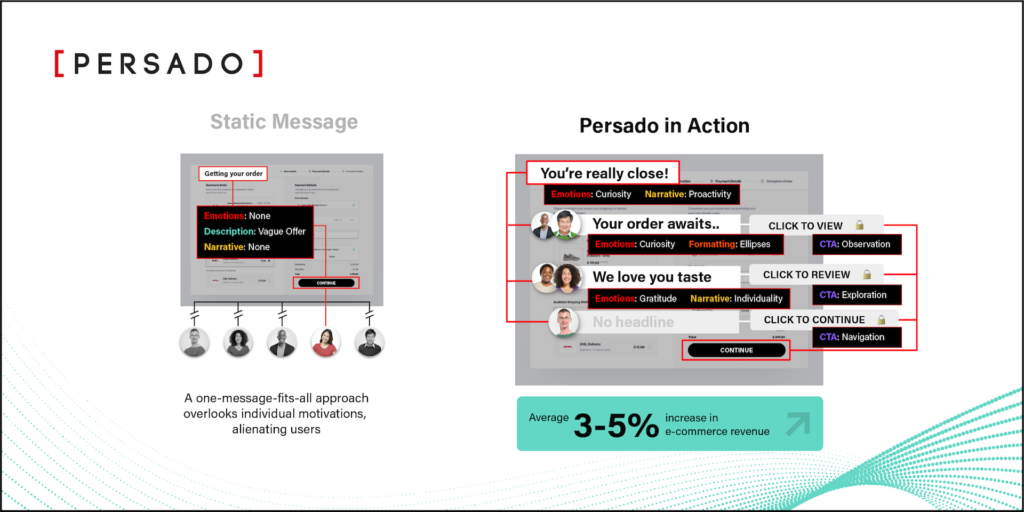
Reason #5: Failing to offer ways to save or favorite items
Solution: Offer wishlists, favorites, and save for later options:
Not all customers browse an e-commerce website with the immediate intent to buy. Give customers the option to save products for later or add them to a wishlist. This can help customers who are not ready to purchase at the moment to come back later and complete their purchase. Otherwise, they may use the online cart to save items that they don’t have the intent to purchase.
Reason #6: An unclear checkout process
Solution: Be transparent about the checkout process:
Clearly communicate what customers can expect during the checkout process. Provide information about what steps are required, how long it will take, and what information customers need to provide. Many brands even opt to show the customer’s progress toward completing checkout by including a bar at the top of the page showing progress.
Reason #7: Lack of clarity around when products will arrive or long shipping windows
Solution: Provide shipping information upfront:
Make sure customers have clear information about shipping, including expected delivery times, tracking information, and any other relevant details about their order. If your shipping windows are too long, customers might change their minds and choose not to buy the products in their cart. As with added fees and costs, shipping information should also be prominently displayed in the listing.
Reason #8: Lack of payment options
Solution: Offer multiple payment options:
According to PPRO, 42% of US-based consumers will stop a purchase if their favorite payment method isn’t available. Retailers need to provide customers with multiple payment options, including credit/debit cards, PayPal, Apple Pay, Buy Now Pay Later, and other payment methods. Payment options not only give customers more ways to pay, they also serve as trust signals that help customers feel more comfortable completing their purchase.
Reason #9: Website crashes and technical issues
Solution: Prevent website crashes:
57% of online shoppers will abandon their cart if it takes more than three seconds for the page to load. Most will not return. Make sure that your website is reliable across all devices by regularly testing your website to ensure that it can handle high traffic and that there are no errors, crashes, or slow speeds. Since average cart abandonment rates are over 80% on mobile, it’s important to make sure your e-commerce store is fully optimized for mobile shopping.
Reason #10: Complicated or unfavorable return policies
Solution: Simplify return and refund processes:
12% of online shoppers will abandon their carts because they don’t like the return policy. Make returns easy for customers who are not satisfied with their purchase. Providing a return label, for example, makes the process as easy as possible. This will convince more people to purchase because they know they can easily return the items they may not be satisfied with. No returns or a complicated return policy give customers a reason to abandon their cart.
Reduce cart abandonment by extending personalization to the checkout page
Retailers have spent millions of dollars trying to understand what their customers want from a personalized digital experience, yet they fail to personalize the most critical point of the buying journey. Ultimately, this can lead customers to abandon their online shopping carts, resulting in lost revenue.
Put simply, personalization equals more revenue. In fact, dynamic AI-generated language has the potential to drive between 3% and 5% more revenue. This can be attributed to using Generative AI and deep learning models to identify the best-performing messages, emotions, and calls-to-actions to create a personalized shopping cart experience at checkout.
While retailers have invested in personalization throughout the digital shopping experience, innovation often stops when it comes to the online cart experience.
Dynamic Motivation for the online cart helps retailers increase e-commerce revenue by 3-5% using their session data and the Persado Motivation AI knowledge base to deliver messaging that motivates shoppers to complete their purchase. This shopping cart abandonment tool empowers enterprise marketing teams with a content personalization strategy during checkout is just one way retailers can reduce abandoned cart rates, increase conversions and revenue, and scale their enterprise.
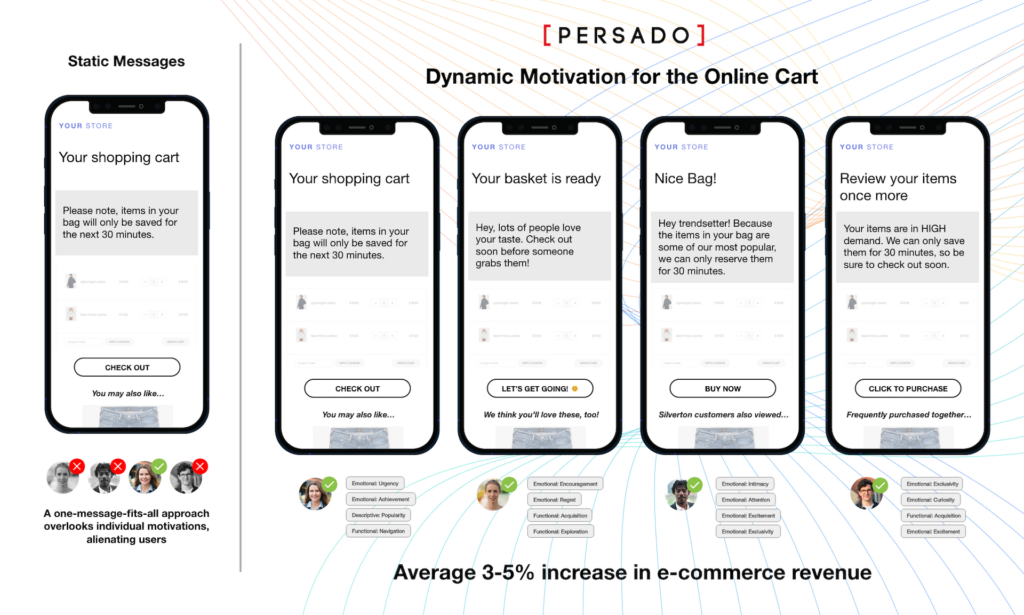
Learn how to get started with Dynamic Motivation for the online cart.
Combating online shopping cart abandonment throughout the digital customer journey
Cart abandonment rates have been relatively consistent since 2014. So retailers need to find new and innovative ways to combat cart abandonment, implement abandoned cart recovery strategies, and inspire e-commerce shoppers to complete their purchases. While many of these strategies may be implemented after the shopping cart has been abandoned, much of what it takes to inspire confidence in a brand and in a purchase comes before the customer hits “add to cart” or in the case of Dynamic Motivation in the online shopping cart itself. Forward-thinking e-commerce brands have their cart abandonment strategy resonate throughout their digital customer journey through seamless customer experiences, upfront pricing and policies, personalized messaging, and added value.


